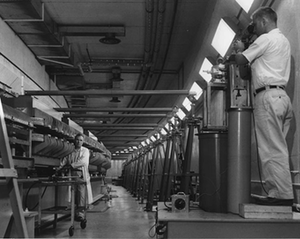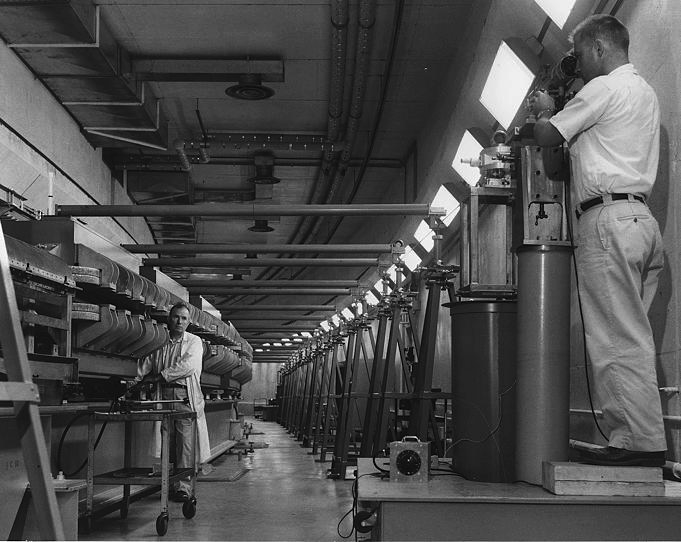Landmarks—Matter and Antimatter are Not So Symmetric
Landmarks articles feature important papers from the archives of the Physical Review journals.
Symmetry has been a guiding theoretical principle for particle physicists, but in a few cases, nature has turned out not to be as symmetric as expected. The 1964 discovery of the violation of CP symmetry—which involves the relationship between matter and antimatter—was a particularly awkward intrusion that even today represents something of a theoretical enigma. Published in Physical Review Letters nearly 50 years ago, the Nobel-Prize-winning discovery hinted at an answer to one of the most important questions in cosmology: why is there is so little antimatter in the universe?
In the early 1950s, physicists faced an odd puzzle involving the neutral K meson, or kaon, and its antiparticle. Through a process involving the weak interaction, the kaon could turn into the antikaon, and vice versa, which seemed to mean that they were not true elementary particle states. So theorists defined new particles: K1 was the sum of the kaon and antikaon states, and K2 was the difference.
At that time, the laws of physics were thought to be exactly the same for matter and antimatter. This principle, known as charge conjugation symmetry, or C, led through some simple arguments to the prediction that K1 could decay into two pions, but K2 could not. K2 could only decay in more complex ways, for example into three pions. This decay would be less common, so K2 would be longer lived than K1. In line with the predictions, experiments showed that K2 was longer lived and mainly decayed into three pions, although a small number of two-pion decays would not have been noticed.
Then a new problem arose. An experiment reported in 1957 showed that the weak interaction does not obey mirror-reversal symmetry, or P, for parity (see 2 December 2008 Focus Landmark), and physicists soon realized that if P was not respected then neither was C, potentially upsetting the K1- K2 model. But there was an out: if the combined symmetry CP was strictly observed, the original model would be preserved, and as before, K2 could not decay into two pions.
James Cronin and Valentine Fitch of Princeton University, along with their collaborators, put that prediction to the test. Using the Alternating Gradient Synchrotron at Brookhaven National Laboratory on Long Island, they slammed protons into a beryllium target to generate a mixture of K1 and K2 mesons. The K1’s decayed quickly, leaving a beam of K2’s.
In among the expected three-pion K2 decays, the Princeton team found a small number of two-pion decays. They concluded that about two in every 1000 K2 decays produced pairs of pions, violating CP symmetry. Cronin and Fitch won the 1980 Nobel prize in physics for their discovery.
CP violation was a surprise, and an irksome one, says Lincoln Wolfenstein of Carnegie-Mellon University in Pittsburgh. “The fact that it was very small, with no other examples, left us wondering whether this was some annoying little effect, not a grand piece of physics.” It was not until 1973 that theorists found a way even to accommodate CP violation in particle physics models [1]. However, the 1973 theory did not gain acceptance for some time, because it required a third “generation” of elementary particles, in addition to the two that were then known. Those predicted particles, including the top quark and the tau neutrino, were observed over the following 20 years.
CP symmetry implies equivalence of particle reactions and their mirror-image, antiparticle versions. CP violation forced theorists to accept that nature has no absolute matter-antimatter symmetry, so that matter and antimatter are not quite equivalent. The silver lining is that a small imbalance between the amount of matter and antimatter in the early universe can explain why there is so little antimatter today: after all the antimatter annihilated with matter, a small amount of matter remained. However, the measured magnitude of CP violation is far too small to account for the observed cosmic density of matter, so experimentalists continue to study the effect in other particles, such as B mesons. In fact there is still no explanation for the magnitude of CP violation, Wolfenstein says. “There are a lot of random numbers in our theories.”
–David Lindley
David Lindley is a freelance science writer, now retired. His most recent book is The Dream Universe: How Fundamental Physics Lost Its Way (Penguin Random House, 2020).
References
- Makoto Kobayashi and Toshihide Maskawa, “CP-Violation in the Renormalizable Theory of Weak Interaction,” Prog. Theor. Phys. 49, 652 (1973)
More Information
Focus Landmark on parity violation
1980 Nobel Prize in Physics (Nobel Foundation)





